Planky - bellyboarding in Europe
Spain: Atlantic Coast
 Youth with txanpero - San Sebastian, 1950-60s. Photo courtesy Iñigo Arina. |
 Salvadoe Artaza's alaia templates. Photo by Jesús Belmonte "Sancheski." |
 Youth with txanpero - San Sebastian, 1950-60s. Photo courtesy Iñigo Arina. |
 Salvadoe Artaza's alaia templates. Photo by Jesús Belmonte "Sancheski." |
The development of surfing in Spain was due to a combination of factors such as exposure to film, books and magazines from the US which featured surfing; local ingenuity and an interest in riding waves whether this be bodysurfing or canoes as well as innovations occurring across the border in France. The first documented Spanish surfboard rider was Ignacio de Arana. He had been the Spanish Consul in Hawaii and in 1914 brought back to Spain two surfboards that he was reported to have ridden in Waikiki along with a copy of the book "The Surfriders of Hawaii". There is no evidence he rode the board in Spain. De Arana died in November 1918 in Newcastle (England) and the board was burnt in the 1936-1938 Spanish Civil war (Esparza 2020).
 |  |  |
Both the planky and later the Malibu style boards that were introduced into Spain were influenced by developments in Biarritz, though boards have been reported as beig ridden as early as the late 1920s (de la mar 2018). Besides bodysurfing, waves were also ridden in canoes. Jose Luis Elejoste an early Spanish surfer describes riding canoes and Marcelo Linasazoro built canoes and plankys. In Spain, the planky was known by a variety of names depending on location. Around San Sebastian (Donostia in Basque) plankys were known as txanpero (or in Spanish Champero). Javier Arteche advises that 'Etymologically, txanpero comes from the Basque word, txanpa. "Take a txanpa" means to take advantage of the strength and movement of a wave, to ride it (it is also used in rowing, "the last txanpa"). Txanpero would therefore mean the gadget that allows someone to take a txanpa. (Arteche 2011). In Cantabria, planky were referred to as planquin, while Sergio Gonzalez Alonso advised that in Asturias they were known as corre olas ("wave runner").
 txanpero. Photo by Gavin Randall of Traditional Surfing UK |  A txanpero purchased in San Sebastián in 1983, by Brian Lowe. Photo by Gavin Randall of Traditional Surfing UK |
The earliest known accounts of riding wooden boards is around Bilbao. Ramon de la Mar Silva documented that in 1934 he and friends (Pereiro, Txano, Ugalde and others) from Amorebieta, rode plankys at Ereaga and Arrigúnaga beaches (Mar 2002). In a 2020 e-mail, his son Joserra added: "The first time my dad rode in Laga Beach. He and friends from Amorebieta used to go from Amorebieta where he passed summer with his grandma to Laga, by train, and passing the river (where is Mundaka) on boat. So they did a "trip" to Laga and someday some friends from Getxo joined, the boys from Getxo took plankys to Laga. Later, he started using planky near Bilbao, Ereaga, Sopela, I think". The boards were reported to be just over a metre long and less than 40 cm wide, with a curved nose. At some stage, boards were sold at a hardware store in the Seven Streets area of Bilbao. In the course of his employment, Ramon was transferred to Gijón (Asturias). While there he asked a carpenter to make him a planky. Ramon and his wife later returned to Bilbao and started a family (de la Mar 2002). Ramon taught his children to ride a planky, however, one planky wasn't enough for four sons and daughter. Ramon's son, Joserra, recalls that around 1974 his mother bought a planky from Irusta, a gunsmith and toy store in the Sands Las Arenas (a neighborhood in Getxo, near Bilbao). Joserra recalls progressing from catching whitewater straight to shore, to catching waves with flippers and doing manoeuvres on waves. He recalls being impressed seeing a surfer in the 1980s, riding a planky with fins, for hundreds of meters at Mundaka (de la Mar 2018). The boards were known as "tabla de coger olas", boards for catching waves and later riding the boards became known as planking.
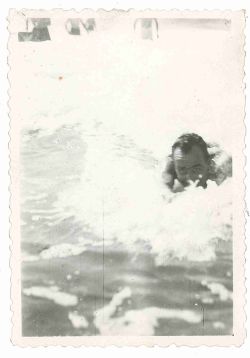 Ramon de la Mar Silva - Sopella Beach 1942. Photo courtesy Jossera de la Mar |
 Mariasun de la Mar Iturraspe en at Plentzia, around 1965. Photo courtesy Jossera de la Mar. |
Salvador (Salva) Artaza Aristondo was given a planky in 1975, which he rode until about 1980, aged seven as a present. Nacho Susaeta,was also bought a planking by his family. He surfed this board at Laida Beach (a beach in front of Mundaka). The boards were sold in traditional sports shops as there were no surf shops at the time. One brand of board that was available was the Tiburon. Josean Ariño (said by Artaza as the last plankinero in Bizkaia) said plankys came in three sizes: small, medium and large. He said the best brand for him were "Tiburon," which were said to be "the largest and most expensive (500 pesetas)". Josean attached skegs to the board for control. Artaza thought he probably surfed Ereaga or Salvaje beach. Ariño advised that Borja de la Quintana also used to ride planking. Julito "Copa Davis" was another local planky rider. Both Artaza and Susaeta have begun to ride prone alaia boards.
 Tiburon planky. Photo by Jesús Belmonte "Sancheski." |
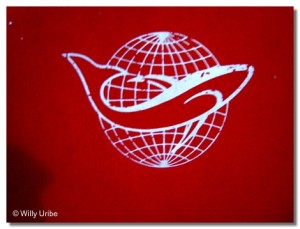 Tiburon logo. Photo by Jesús Belmonte "Sancheski." |
One of the first surfers to ride a conventional surfboard was Jose Luis Elejoste who started bodysurfing and riding prone in Zarautz (Gipuzkoa province) in 1940, at age 15. He recalls Angel Berazadi being one of two others in the water bodysurfing. Two years later he began planking on a board his brother made. In an interview, Elejoste stated: "In 1952 I broke my planking (the one my brother had made for himself) and I made three boards (plankings) of 33 x 130 cm. (I made them) out of a wooden plank from a special aeronautics timber. I boiled some water, soaked the front of the boards and when they were soft, I curved them at the tip allowing them to dry well, I cut them out and painted them with stripes" (Uribe 1990). Elejoste recalling surfing at Larrabasterra, Peñatxuri and Ereaga. By 1957 he reported that planking had increased in popularity and he was being asked to make boards for friends. Eventually, he recalled making 50 boards, selling 22 and then selling the remainder to a Bilbao sports store. When asked to make more, he suggested calling a carpenter as the boards were easy to make. He stated: "They did, and soon after started selling them like hotcakes costing 130 pesetas each board". Joserra de la Mar (2018) who also interviewed Jose Luis Elejoste noted that the original planky was made by his brother-in-law (Pereiro) around 1926-1928. Others who rode plankys included some Arísteguis, the Estrades, and seven or eight others. Elejoste reported seeing the board (likely unridden during the civil war), at his brother-in-law's house at Algorta.
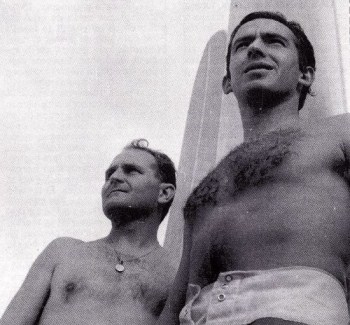 Jose Luis Elejoste (left) and Juan Carlos Pradera, c. 1965 Photo Uribe (1990). |
Iñaki Arteche, Javier's elder brother has said that the first time he saw a txanpero was in 1944-1945, in Zarautz. The board was owned by Javier Isturiz, the son of the notary of Zarautz. Other young people were said to have rode and shared this txanpero. Javier Arteche has said that the beach mostly surfed was La Concha, with other beaches such as La Zurriola being considered too dangerous. These boards were described as about 4-foot long and 1-1/2 feet wide, with a rounded curled nose. The boards were very popular until around the 1980s, though Javier Arteche noted that his friends who rode these boards did not progress to standup surfing, which he became aware of through his brother who made his first surfboard in 1964 (the inspiration being a 1963 cover of a Life magazine) though his brother's first exposure to surfing was brief glimpse in the movie Captain Blood. Arteche advises that with flippers he and his friends were able to angle across unbroken waves, otherwise it was riding straight to shore.
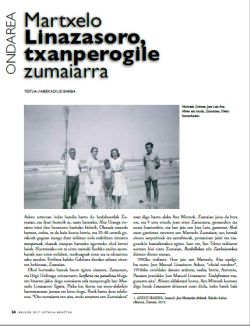 Article on Marcelo Linasazoro by Xabier Azkue Ibarbia Photo courtesy Baleike, July-August 2017 |
 Jose Luis and Ane Miren, the children of Marcelo Linasazoro with txanpero Photo courtesy Baleike, July-August 2017 |
One manufacturer of plankys was Marcelo Linasazoro, a carpenter who visited Biarritz in the 1950s. His boards were made in a press and according to his family the curved tail on these boards was Marcelo's innovation to differentiate his boards from copies (Linasazoro 2012). The French plankys, in contrast, had square tails. Jacky Rott, who made planky's in Biarritz, also noted that the press used by Linasazoro was similar to his, though in Spain 4ply was used whereas he used 5 ply in his boards. (Zibin 2013).
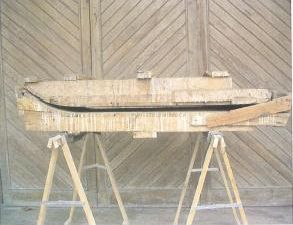 Linasazoro txanpero mould Photo Lázaro Eizaguirre Echegaray and Mikel Berasategi Troitiño(2007). |
 Linasazoro style txanpero. Photo by Gavin Randall of Traditional Surfing UK |
Another source of planyks was identified in 2010. A stock of planky blanks were reported to have been found at an old carpenter shop (Carpinteria Azkue) in the Basque Country, "piled and forgotten in a dark corner at the far end of the workshop". These boards were given a new life with image of a local Surf Film Festival on them and the Amstel Surfari (Arteche 2011, Garmendia 2011).
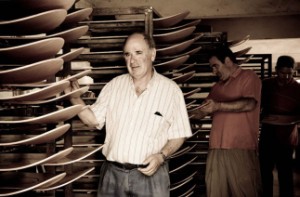 Workshop of Carpinteria Azkuee. Photo © Surfilmfestibal. |
 Linasazoro txanpero mould. Photo Lázaro Eizaguirre Echegaray and Mikel Berasategi Troitiño(2007). |
Jose Manuel Gutierrez (Meco) was one of a group of spearfishermen surfers from Cantabria in the 1960s. Godofredo, the Santander shop he purchased his planky from in 1962 was the same store from which he and other members of the Centro Investigaciones Submarinas (CIS) club bought their spearfishing equipment. He is not sure where the plankys came from. The boards were painted and they added keels to "edge the waves better". Without the keel the boards were also used in the snow. The planquins, were used when the conditions weren't suitable for fishing. Meco advises "We rode the planquin for a year or more before we saw the first surfboard and Juan Giribte made a wood board and we learned that they were sold by Barland-Rott in Biarritz. It was in 1964, and we quickly drove our car [to buy] a surfboard. This is more or less the history of the planquin in Cantabria". Others who rode plankys were Rafael Molina (who at 49, thought he was too old to try standup surfing), Manuel Martinez (Lolis) and Antonio Sáez. In 1962 Jesús Fiochi, a teenager from Santander fitted a planky he bought in Biarritz with a couple of fins and starts bellyboarding in El Sardinero Beach (Verger 2012).
 Planquin with fin, Islares beach, 1964 Photo courtesy Meco. |
Iñigo Arina used to surf txanpero with Mikal Troitiño at Zarautz, in the summers of 1981 and 1982. At the time he was 13 years old. The board was bought from the ice cream shop in Zarautz, next to the old PUKAS store. The cost of this board was 700 pesetas. At the time there were few others riding txanpero with fins and catching waves. Elou Ollarzabal was another txanpero surfer and Lazaro Echegaray recalled that in September 1982 they referred to themselves as the Wolf Planking Team. Otherwise there were some children riding txanpero in the white water. Iñigo painted his txanpero and put a fin on the board, using two screws. He also experimented with a wristband consisting of a velcro and rope. However, this wristband was unnecessary as it was easy to hold onto a txanpero. Iñigo recalled that the board with a curve in the tail was better and that for teenagers the narrower boards were easier to catch waves on, as the wider boards flexed more. Besides Marcelo Linasazoro in Zumaia, Iñigo recalled that his neighbour Azkue, was a carpenter who also made txanpero at his factory. In recent years, Iñigo has again been riding txanpero.
 txanpero. Photo courtesy Iñigo Arina |
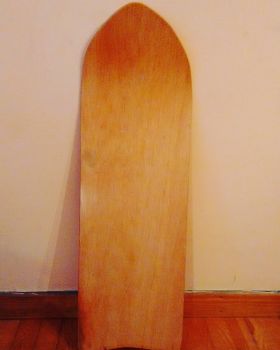 Linasazoro txanpero, made c. 1978 Photo courtesy Iñigo Arina |